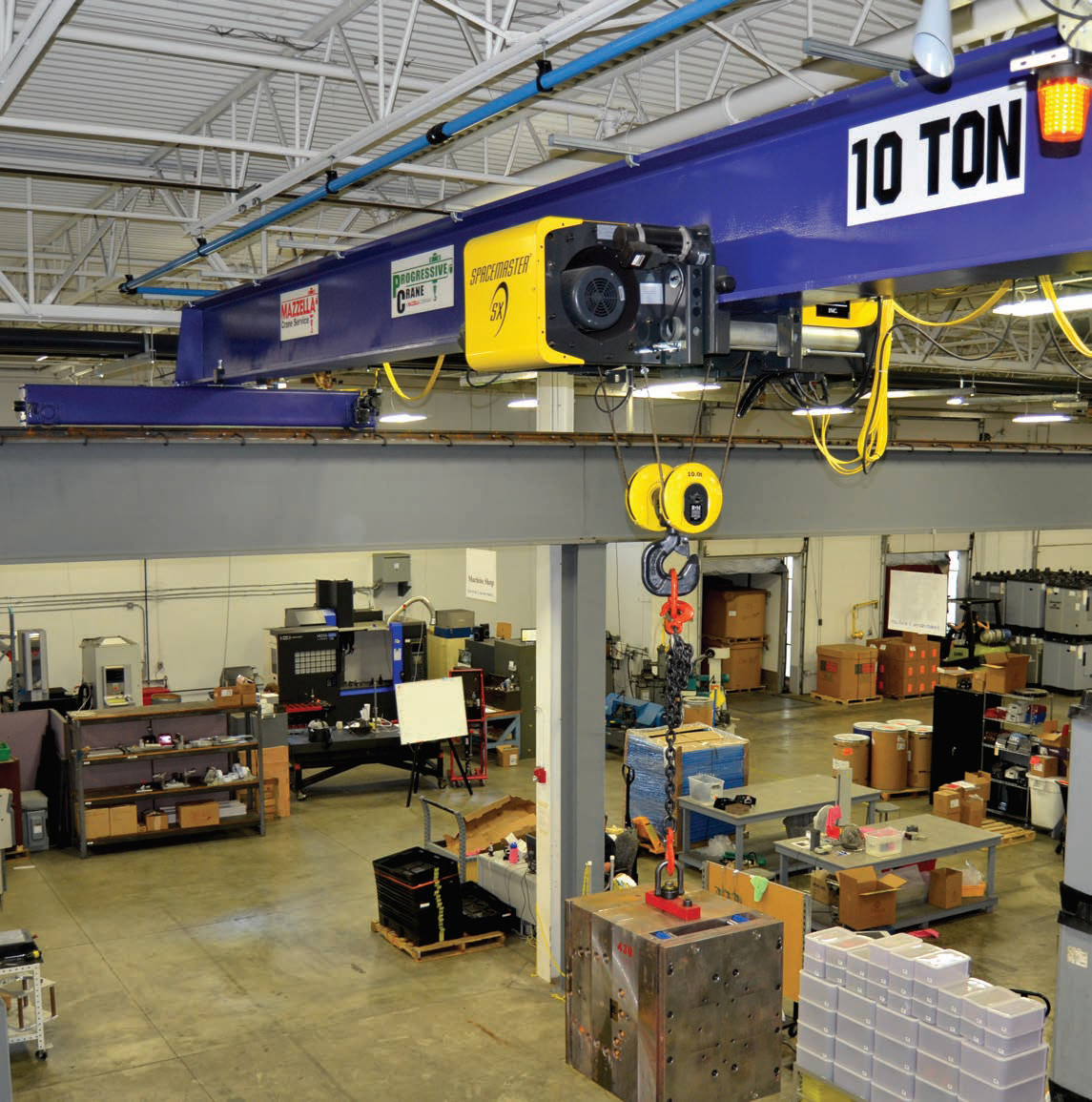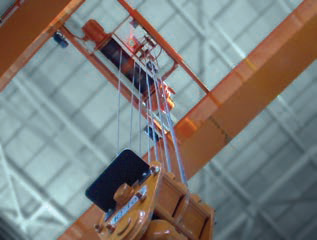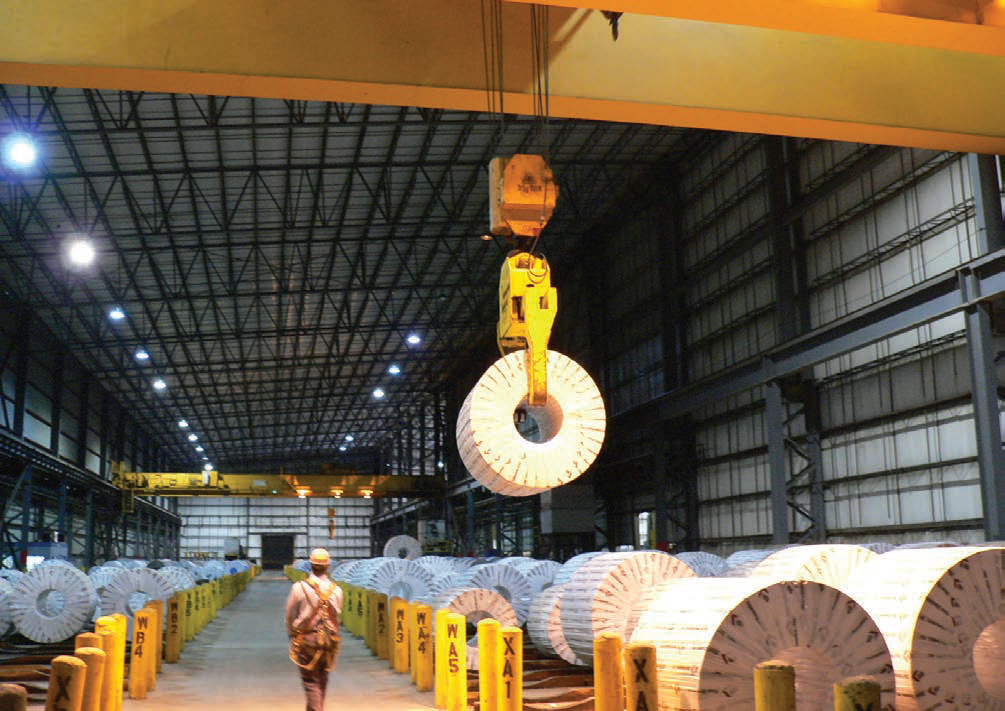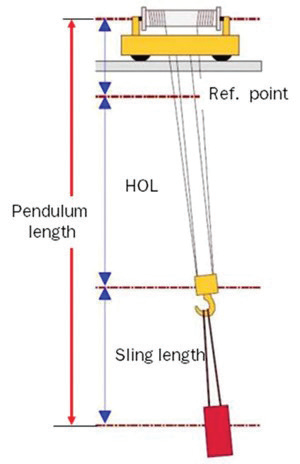Sway away
19 June 2019Accomplished hoist operators can move a load without causing it to sway. But it is a skill acquired only with training and experience. Julian Champkin finds that anti-sway systems do even more than the name suggests.
Almost all manufacturing plants use cranes or overhead lifting apparatus. The safety of that equipment, and its efficiency and productivity, is largely down to the person who operates it. An experienced and skilled operator will work more efficiently, and have fewer accidents, than a novice.
That might seem a statement of the obvious. Yet in practice, in very many factories and facilities, untrained and novice members of staff often use hoists and perform many of the lifting operations. That might be because a pendant-controlled hoist seems an easy machine to use: press the up button on the dangling remote, and the hook goes up; press ‘along’ and it moves along.
That appearance is deceptive. Not very much thought, and not very much experience, will show that any load will sway when it is moved, and sometimes that sway may be dangerous. In any case, controlling it is not always easy or obvious. It takes skill. Which is why anti-sway systems have been growing in popularity. Many manufacturers now offer them; their use is not yet the norm rather than the exception, but as prices come down and automation becomes cheaper, they may be set to become so. “Ten years ago, crane anti-sway was seldomly a serious consideration for most end users,” says Dr. Khalid Sorensen, Chief Technical Officer for PaR Systems, whose ExpertOperator anti-sway system is at the cutting edge. “Now, however, people in our industry are more acutely aware of the hazards posed by load swing, and the great safety benefits of adding anti-sway.”
Thus Demag, SWF Krantechnik, Konecranes and Smart-crane all have offerings in the sector (see Hoist, June 2018). ABUS have their Abucontrol system, which can even be used for tandem lifts, as demonstrated at a steel fabrication plant in north-eastern Spain.
Their principles of operation vary, but almost all anti-sway systems depend on data, about the height, speed and position of the load and trolley, measured directly or indirectly by sensors and fed into software that in turn adjusts the movements of the trolley. One essential of anti-sway is that the movements of the overhead trolleys need to be very precisely controlled in order to cancel out the swaying of the load. In practice this means that frequency inverters on the trolley drives are a requirement; but these are becoming evermore the standard these days.
Aside from load sways being inherently dangerous—a heavy load swinging at the end of a rope in a busy factory is not a good idea— it is inefficient: a load cannot be set down until it has stopped swaying, and if you are waiting for natural air-damping to achieve this you may be waiting for some time. The heavier the load, the longer it will take.
R&M’s ControlMaster anti-sway system is an optional feature for the company’s QX modular crane package. The company recommends it for applications that require handling of delicate or critical loads. Examples they suggest include glass products, satellites, or aerospace equipment; but it is equally appropriate for heavy and robust loads, whose swinging takes up time, and whose impact in the event of a collision could cause damage and injury.
Their system works by registering the speed command that is entered at the controller. It brings the trolley to that desired speed, but does so with accelerations that keep the trolley at all times over the load. This prevents sway from developing. It uses a mathematical calculation to estimate the load swing. The calculation is based on the distance between the centre of the rope drum and the load—in other words, the pendulum length. As Galileo discovered in the 15th century, a long pendulum swings slowly, a shorter one swings fast.
Additional features such as an anti-sway indicator light, encoder-type height sensor, and radio controller with a sling length selector switch provide additional precision and safety.
Calibration of the system, they say, is quick and easy and is carried out on-site by an R&M factory representative.
One feature all such systems share is the easing of the crane operator’s burden. “Crane operators actually have a lot of things on which they must simultaneously concentrate,” says Sorensen. ‘They have to manipulate the load to a desired location, but they have to do it while controlling load swing, avoiding collisions with both fixed and moving obstacles, walking with the load through the workspace, communicating with co-workers, and all the while they must be correctly actuating the pendant or radio buttons.” That is why operators receive training, and why a practised, experienced operator should be worth their weight in gold. Sorensen has designed PaR’s ExpertOperator anti-sway system, which addresses precisely those issues, and has authored numerous papers on the subject.
Yet despite the complex demands of hoist operation in a busy and crowded work environment, an academic study of crane work practices by R. Geddes found, in author’s words, that “virtually everyone on the production floor will at one time or another operate the crane.” That study took place in 2009; but it is unlikely that the situation will have changed radically since then.
The results are unfortunate. Studies show that the vast majority of collisions are due to operator error. In one factory studied the proportion was 88 out of 101 incidents. The crane operations in that case study involved moving metal coils to and from cooling racks; the collision incidents therefore were not trivial. The costs associated with them were very large, and included costs of scrapping or reworking coils, crane repair, rack repair, lost production—and also operator injuries.
In 248 crane incidents reported to OSHA between 1997 and 2007, it was estimated that 70% of them might have been avoided had the crane personnel been operated in accordance with proper procedure and practice. “It is worth emphasising that this study only examined incidents in which an OSHA report was generated,” says Sorensen. “These represent only a small fraction of all global crane incidents, which may easily number in the thousands.”
The advantages of a skilled, experienced crane operator are therefore manifest. Indeed, they are of paramount importance. In real life, however, operators are in the nature of things likely to vary in skill, experience, ability and the degree of their expertise.
Hence the importance of expert crane operators, and of systems that aid novice operators to avoid problems like load swing. Sorensen says that the effect of PaR’s ExpertOperator technology is to modify the inputs of an unskilled crane operator to make them resemble those of a skilled expert.
“ExpertOperator has a single function,” he says: “It is to help crane operators of all skill levels perform like expert crane operators; and in doing so, it enhances the safety and efficiency of crane operations.”
To understand how it works, it is worthwhile to look at the difference between the way that an expert and a novice operates a crane.
To stop a trolley moving in a forward direction, novices would simply remove their finger from the ‘trolley-forward’ button. The abrupt stop would cause the load to sway. Experienced operators, however, behave more skilfully. Instead of just taking their finger off the button they press and release the button several times. The first halt starts the load swaying; then the trolley moves on a little, counteracting that sway; a succession of such stops and starts eliminates the sway completely. Of course skill is required to judge the timing right; effectively the operator is pre-empting the sway of the load.
“ExpertOperator uses exactly the same strategy,” says Sorensen. “It subtly adds correctly-timed button pushes to all the commanded motions to reduce sway. That means that whenever an individual uses ExpertOperator, it doesn’t matter whether he or she is a novice or experienced; the resulting motion of the crane will be as if an exceedingly skilled operator were driving.”
ExpertOperator intercepts the operator’s pendant or radio-pendant commands; then it modifies them into commands similar to those that would be issued by a skilled operator undertaking the same task.
ExpertOperator is unique in the industry, says Sorensen, as the system does not use any sensory data, whatsoever. No sensors are involved. It does not need to know the length of rope paid out, sling length, or the speed or acceleration of the trolley. “ExpertOperator is the only anti-sway system that is 100% sensorless,” he says. This might seem counterintuitive, not to say an impossible thing to achieve; but it has its roots in Dr. Sorensen’s PhD thesis in the mathematics of crane control. “If, for example a crane was commanded to move very, very slowly, the crane would exhibit practically zero load swing, irrespective of position or height of the load. In a similar way, ExpertOperator uses commands that work for all rigging configurations, but allow the crane to operate at its maximum speed and acceleration.” This means that ExpertOperator will work for any crane load, at any time.
This of course simplifies the installation of our anti-sway system. “The only parameters we need to know about the crane are the maximum capabilities of the drives, and maximum lift—so we do not command motions that exceed the crane capabilities. We do not need information about its positon at any one time.”
Gains from its use, says Sorensen, are manifold. There is, of course, virtually no sway to the load—and therefore less risk of accidental collisions with walls, objects or people. Real data from customers that have had ExpertOperator installed show that a reduction of load swing by approximately 95% is typical. That can mean the difference between a few feet of sway to a few inches of sway. The load path is smoother and more predictable—following the path set for it almost exactly—and the positioning of the final load drop is accordingly more precise. Drop position is also attained far more easily and more quickly, with many fewer final adjustments. The system has been shown to reduce the time required for load positioning by at least 20%, by 50% in some cases, and by an average of 34%.
Because ExpertOperator converts all operator commands to ‘skilled operator’ commands, its interventions will be greater— and its benefits greater—if a novice is operating than if a skilled operator is at the controls. In either case, the number of buttonpresses that the operator needs to make is greatly reduced. This makes the crane easier to manipulate; and, importantly, reduces the concentration needed for manipulating the crane. The result is that the situational awareness of the operator is improved. That is, the operator is more fully able to be aware of his surroundings, of obstacles or people in his path, and the like—thus increasing safety.
It might seem obvious that the main benefits of anti-sway system are in reducing sway. Again, the obvious does not tell the whole story. “The advantages are many,” say R&M, “and are not limited to increased safety and reduced waiting times for setting down. Swaying strains the hoist mechanically, increasing wear and reliability issues. The operator is free to focus on the load and the surrounding area, creating a work environment that is both fast and safe.”
Sorensen says the same. Making the crane easier and more intuitive to use reduces the strain on the operator, which increases efficiency, productivity and safety. Some views from operators who use them, quoted in one of Sorensen’s papers, are illustrative. “It felt much safer,” said a novice. “The stopping distance remains, just with limited swing when it was reached. There is less stress in constantly monitoring the load,” said a moderately-experienced user. And, from an expert: “Incredible; it quickly builds confidence.”
Indeed reducing or eliminating sway may not be the selling points of such systems says Sorensen: “End users care about safety, maintenance, production efficiency, and operator proficiency. PaR’s anti-sway technology is simply the means by which we deliver on those hugely important R ExpertOperator on a 10t hoist factors.”




